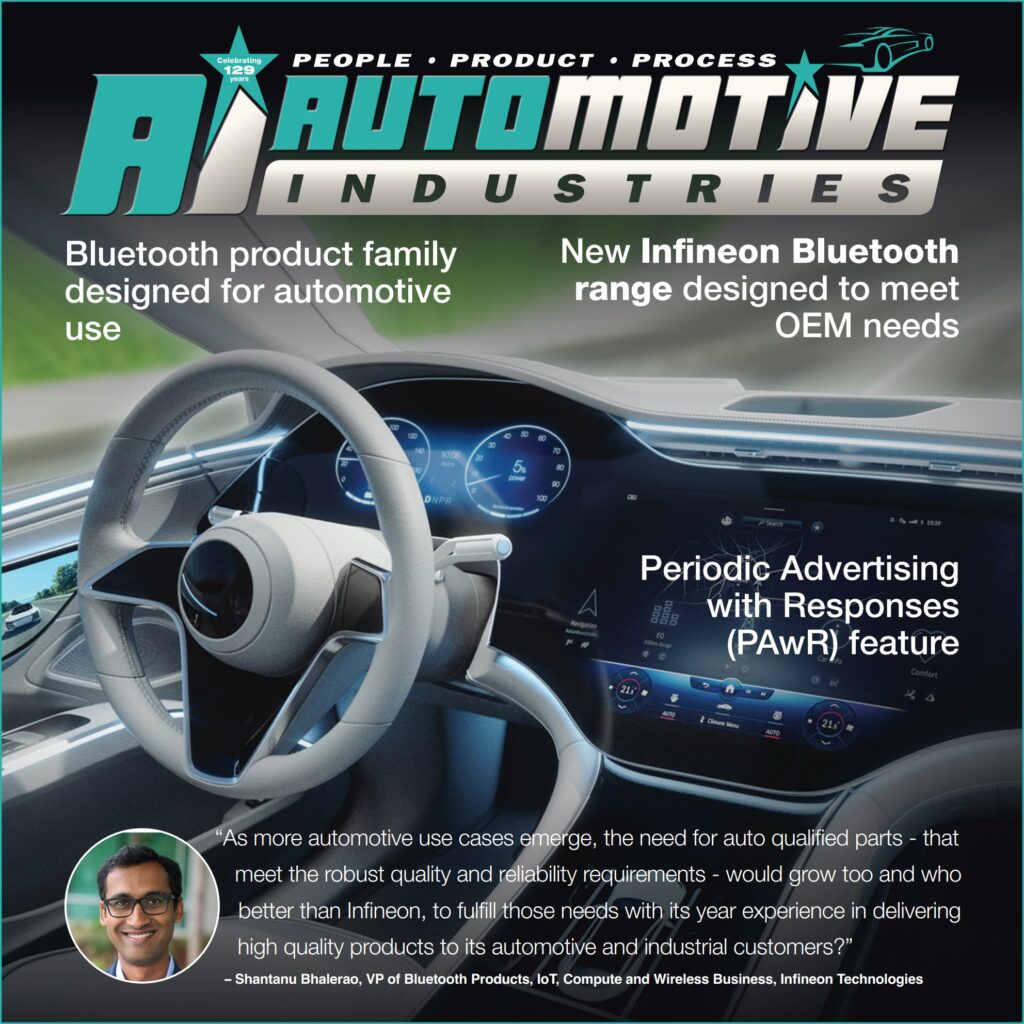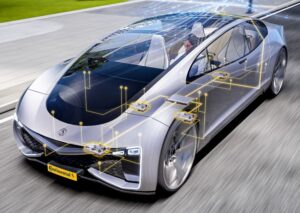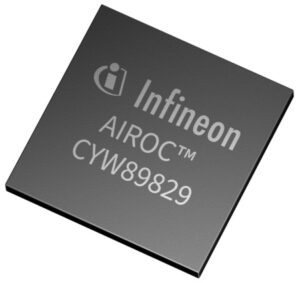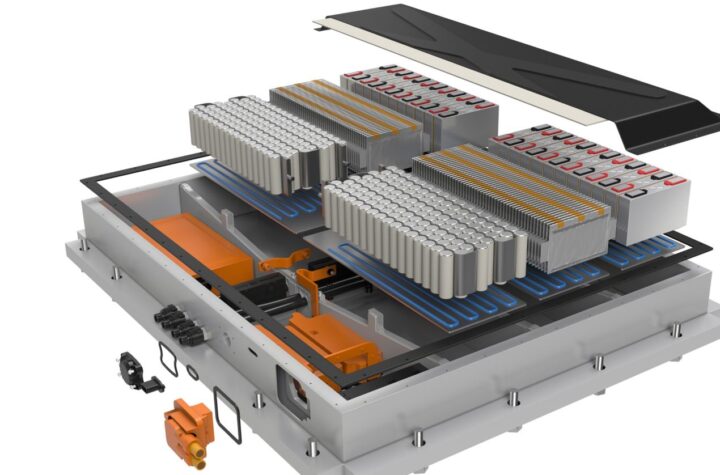
A new range of Infineon Technologies AIROC CYW20829 Bluetooth low energy 5.4 microcontrollers (MCUs) designed specifically for the automotive market opens up opportunities for new OEM revenue streams while reducing component complexity.
The AIROC™ CYW89829 Bluetooth® LE MCU is Infineon’s latest automotive qualified addition to the AIROC™ CYW20829 family.
It supports automotive applications such as car access, wireless battery management systems (wBMS) and LE Audio based rear seat entertainment systems.
The CYW20829 platform is a proven Bluetooth LE MCU in real world applications from up 2.3 km long range to exceptional throughput in an office environment. Leveraging the benefits and foundation of the CYW20829 family, the CYW89289 is a high-performance, ultra-low

power integrated dual Arm® Cortex®-M33 MCU built for industrial and automotive Bluetooth® applications.
Most of the new parts are currently sampling with the SoC solutions available in standard QFN or BGA package options, according
to the company.
Automotive Industries (AI) asked Shantanu Bhalerao, VP of Bluetooth Products, IoT, Compute and Wireless Business, Infineon Technologies, what motivated the company to expand its Bluetooth portfolio with the AIROC CYW20829 Bluetooth Low Energy 5.4 MCU family, and what key features set it apart from previous generations.
Bhalerao: Infineon is a trusted Bluetooth® partner, with over 20 years of experience in microcontrollers and Bluetooth. The company ships over 350 million units annually with its Bluetooth IP and has over 277 patents issued or pending.
We expanded our Bluetooth portfolio with the AIROC CYW20829 Bluetooth Low Energy 5.4 MCU family because we wanted to address the automotive market, since our earlier products in this family addressed the consumer and industrial markets.
The new Infineon AIROC™ CYW89829 in this family of products specifically addresses automotive use cases including car access, wireless battery management systems and LE Audio based rear seat entertainment applications.
The key features in these products include optimized SOCs and modules; robust RF performance, enables long range and all the latest Bluetooth 5.4 features including PAwR; dual ARM core design of the chip family.

As more automotive use cases emerge, the need for auto qualified parts – that meet the robust quality and reliability requirements – would grow too and who better than Infineon, to fulfill those needs with its years of experience in delivering high quality products to its automotive and industrial customers?
AI: How does the new AIROC™ CYW89829 device enhance car access and wireless battery management systems?
Bhalerao: It is ideal for automotive use cases utilizing a Bluetooth® low-energy microcontroller.
The device enhances wireless battery management systems (wBMS), car access and LE audio based rear seat entertainment applications with a more robust RF performance, leveraging Bluetooth 5.4 features using its latest PAwR technology including bidirectional connectionless communication and low-energy connections to enable new applications in vehicles.
AI: Please elaborate on the importance of Bluetooth 5.4 features, such as Periodic Advertising with Responses (PAwR), in the automotive sector?
Bhalerao: The new feature, Periodic Advertising with Responses (PAwR) is important to the Bluetooth 5.4 specification because o
f its advertiser/broadcast and scanner/observer features.
This includes bidirectional connectionless communication for seamless connectivity, along with the ability to connect to multiple nodes. All these features will enable new automotive applications.
AI: What challenges did Infineon face during the development of the AIROC CYW20829 MCU family, and how were they overcome?
Bhalerao: During the development of AIROC CYW20829 MCU family, the Infineon design team had to consider how to deliver seamless connectivity in noisy environments, while ensuring our microcontroller and Bluetooth worked together to deliver flawless RF performance.
Range is always an issue for various applications, and we wanted to deliver the industry’s best range with our Bluetooth solution. Additionally, power efficiency for battery-operated devices is quite important.
To overcome these challenges, we leveraged our system and decades of expertise for Bluetooth and MCUs to provide an innovative solution that is power efficient with improved RF performance and long range.
AI: How does Infineon ensure the security of sensitive data in applications using the AIROC CYW20829 Bluetooth Low Energy MCUs?
Bhalerao: Infineon has over two decades of security expertise and brings together a highly integrated microcontroller and CAN FD. The security features in the microcontroller includes encrypted secure XIP, secure OTA and uninterruptible boot ROM to mitigate adversaries.
AI: What feedback have you received from customers using the new AIROC CYW20829 devices?
Bhalerao: We have received positive feedback from lots of our customers. One interesting use case being “Industrial Robots,” where the PAwR feature along with encrypted advertising data and long range enables deployment of the fleet of wireless robots in a warehouse
We are also seeing lot of traction on automotive applications like wBMS, Car Access, LE Audio based rear seat entertainment applications where the RF performance of CYW89829 stands out
AI: How do the AIROC CYW20829 Bluetooth MCUs contribute to reducing the overall bill-of-materials (BOM) and device footprint in automotive designs?
Bhalerao: With Infineon’s highly integrated solution, it brings the best MCU and Bluetooth low energy to lower the overall bill of materials. With a 10dBm outpower it reduces the need for an external PA.
It provides customers flexibility in choosing a chip with or without flash. Additionally, these products can be available in a module to simplify the design process for our designers.

It supports all features in the Bluetooth Low Energy 5.4 specification, including highly integrated MCU with CAN FD (Cortex-M33; 32 GPIOs; PSA level 1 secure); and includes a robust software and Ecosystem (free RTOS and Zephyr).
AI: In what ways does the dual ARM Cortex core design of the AIROC CYW20829 family improve performance and power efficiency?
Bhalerao: Infineon’s AIROC CWY20829 family utilizes the Arm® Cortex® M33 96 MHz core because a dedicated core for application provides maximum MIPS and wireless stack isolation. The Cortex M33 is also more power efficient over its predecessor M4.
Also, the clock speed operational flexibility between 48MHz and 96MHz allows to choose between power and performance for a given application. This powerful core is dedicated for various applications in the consumer, industrial and automotive sector.
Additionally, the core provides the right blend of real-time determinism, efficiency and security and includes a secure foundation. Additionally, the combination of this core, along with our Bluetooth low-energy reduces design cost with digital signal processing, SIMD, and MAC instructions to decrease the overall time-to-market.
AI: Looking ahead, what future developments can we expect from Infineon’s Bluetooth product line, especially in the context of automotive innovation?
Bhalerao: Infineon is always looking at future developments to support customers requiring Bluetooth connectivity in consumer, industrial and automotive applications.
Infineon is excited that its CYW20829 family delivers the industry’s best range and noise immunity—up to 2.3 km line one of sight without needing a power amplifier.
We will continue to offer innovative software solutions to our customers and enable the ecosystem play. Additionally, we are excited for new use cases in the car with consumers and for them to enjoy better noise immunity, better connection, and less latency for these use cases from gaming to passenger comfort, infotainment, car access and wireless battery management.





More Stories
DuPont materials science advances next generation of EV batteries at The Battery Show
How a Truck Driver Can Avoid Mistakes That Lead to Truck Accidents
Car Crash Types Explained: From Rear-End to Head-On Collisions